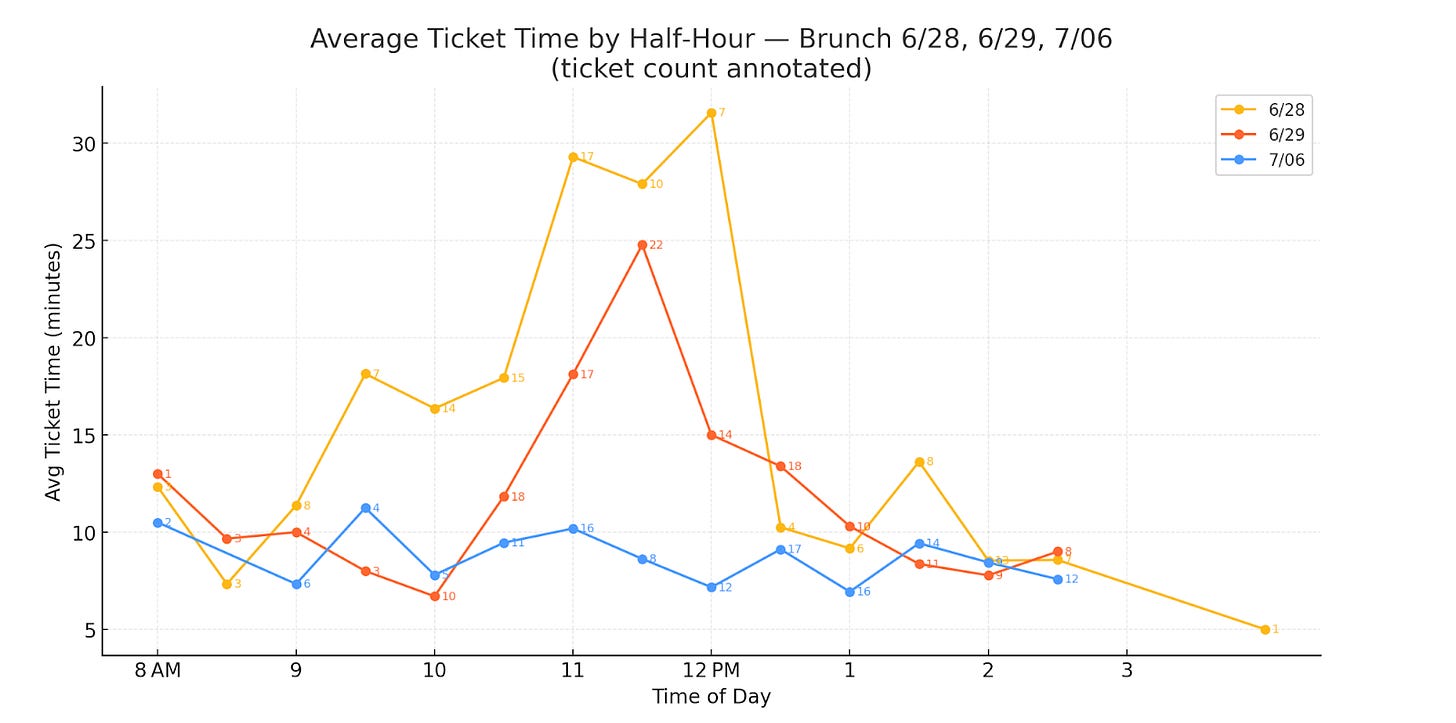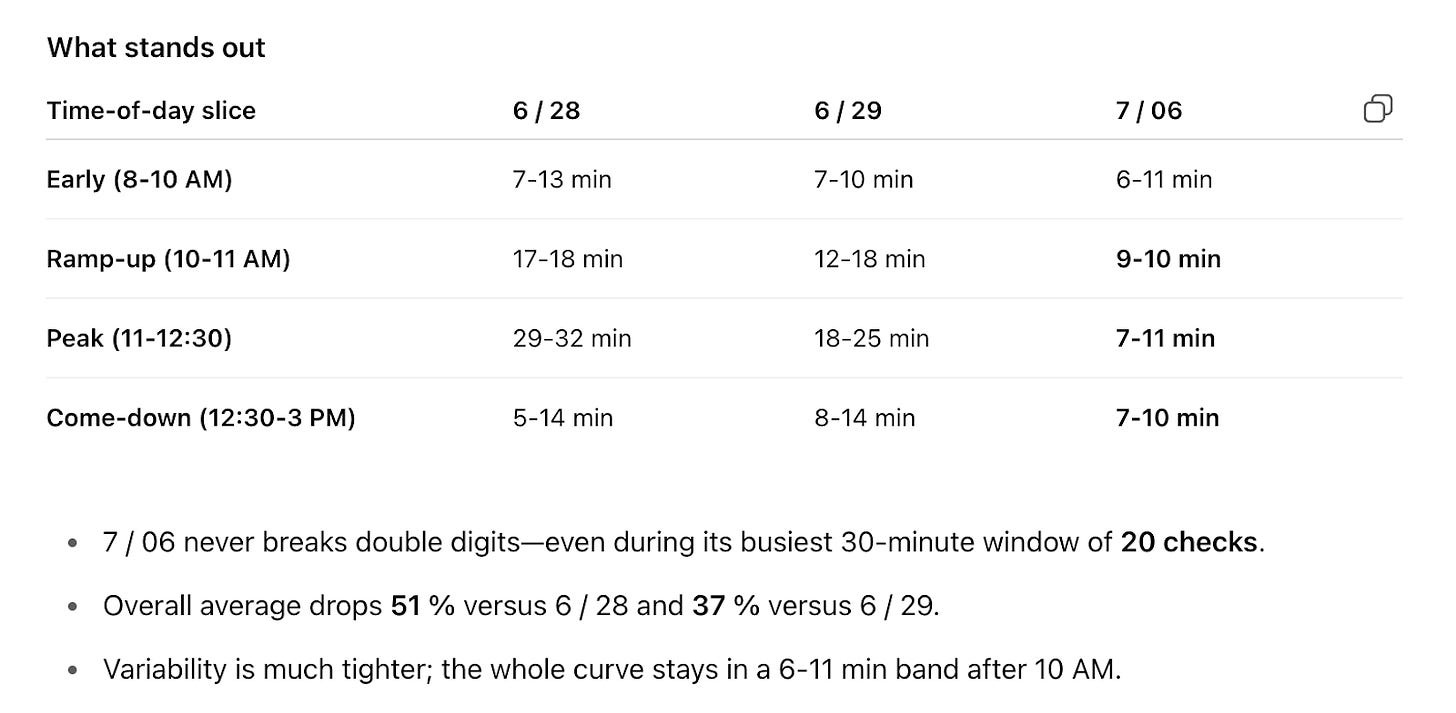We had a very hard brunch a couple weeks ago at our Fenway location. The restaurant is only 4 months old and the team has done an exceptional job handling Red Sox games, graduations seasons, concerts, etc.; brunch has been our most challenging service. By 9:45AM on Saturday June, 28th it was clear we were going down. By noon, our average ticket time had gotten to over 30 minutes. Our longest single ticket clocked in at 45 minutes. Guests were understandably frustrated. Comps piled up. Our team, both FOH and BOH, were demoralized.
In the moment, the goal was to get the food out as quickly as we could and the team persevered. I was never a good line cook so the most helpful I could be was to observe, capture what was happening and try to help prevent a similar situation in the future. I stood at the end of the line and took notes, photos, and videos.
After service we ran some reports to see how bad it was. The numbers told the brutal story: an overall average of 17.5 minutes per ticket, with peak times stretching to 31 minutes during our busiest half-hour. During what should have been our sweet spot—the 11 AM to 12:30 PM rush—we were consistently hitting 29-32 minute ticket times. For context, we aim to be no longer the 15 minutes, ever.
What went wrong? Where were the bottlenecks? How do we prevent this from happening again? Truly analyzing and diagnosing this with the traditional restaurant tech stack is painful so more often than not we ‘commit’ to doing better next time. We always mean it but without actionable insight as to ‘The Why’, these things don’t solve themselves.
This time, we tried something different.
We uploaded our Toast product mix, ticket fulfillment data, and photos & videos from the line to ChatGPT. A sous chef used a sharpie to mark a physical menu with Grill, Saute and Fry. Our prompt was pretty simple…"Here's our data and some images from today's brunch service. WTF went wrong?"
Within 5 minutes we had most of the insights we needed to start to solve the problem.
The product mix report plus the Sous Chef’s station legend revealed that 67% of dishes were coming off of grill station
25% of the 208 dishes coming off the grill are wraps
From the video we, chatgpt + chef team, identified a number of issues with where the mise en place (ingredients) was kept for wraps
When the station got busy it wasn’t efficiently designed for two people work in tandem with out significant crossover and confusion
Mise within the refrigerated sandwich top was not efficiently placed based on the frequency of use. For example, an item that only sold occasionally had one of the most economical placements in the station while top selling items required a longer reach
The AI was able to synthesize orders, ticket times, product mix analysis and the real world imagery in seconds. This would have been prohibitively time consuming with only the reporting tools from Toast. 30 minutes after doing the analysis we were able to draft a new line layout for both chef and AI feedback.
The new layout is optimized for efficiency and throughput with the station split into two sections for peak times while still maintaining the ability for a single person to work it off peak times. We uploaded this new diagram along with the previous reporting to get AI feedback. It pulled in product mix data and estimated time savings per wrap and overall savings through a shift. It recognized the inefficiencies of all the door opening of a C-Vap from the video and images and referenced it to affirm the steam table decision. When we said we were concerned about overcooked scrambled eggs in the steam table it suggested ramping down batch size as business volume tapered off. It also suggested a shallower ⅓ to lessen overcooking risk.
The results here were pretty profound and immediate. We made the adjustments we could heading into Sunday. We couldn’t get the steam table for Sunday but reoriented around the structured 2 person grill roles with one on griddle and the other wrap station. Even with the minor tweaks we saw marked improvement. Average ticket time at peak volume fell from 31.3 minutes on Saturday to 24.9 minutes on Sunday. Still not great but it was on more tickets and a 20% reduction in ticket times felt great for the whole team.
The next weekend was July 4th, historically very slow for most Boston restaurants. We spent the slower Friday and Saturday getting the line setup exactly as shown in the diagram. Sunday saw comparable volume to the previous weekend and the improvements were dramatic. Average peak volume ticket time dropped from 31 minutes to around 9 minutes!
The consistency was as impressive as the speed. Instead of wild swings from 7 minutes to 32 minutes depending on the time of day, our entire service stayed within a tight 6-11 minute band after 10 AM. During peak brunch hours—the same time period that had killed us two weeks earlier—we were consistently hitting 7-11 minutes per ticket.
When people ask how AI is helping us in our restaurants, I usually give some vague answer about "bringing it to everything." That doesn't really help anyone understand what that means in practice. This is what it looks like: operational problem-solving in real time, using AI for efficiency but more importantly as a thought partner capable of amplifying our own abilities.
The broader implications are significant. This kind of analysis—synthesizing multiple data streams, identifying workflow inefficiencies, suggesting operational improvements—is what AI is exceptional at. One of the biggest tech frustrations for many restaurant operators is the walled garden nature of the tools. Toast doesn’t meaningfully talk to Opentable or Quickbooks, for example, and restaurants suffer as a result. Best I can tell, the argument for this is mostly rooted in protecting turf and potential future revenue through feature add ons. I’m not sure this argument ever would have resonated but it’s particularly indefensible with the advances in AI. I’d also argue it’s stupid because innovative operators are already finding ways to pull their data out of the standard tech stack to bring it to infinitely smarter tools like ChatGPT and Anthropic.
A few hours ago I bumped into the Sous Chef in Fenway and he said he’d seen my email about the time improvements. He was happy and proud of this but was much more excited to talk about the change in the energy and confidence on the line. He said the anxiety level dropped as much or more than the average ticket time. I’ve never doubted that AI could help make our restaurants better places to dine and work; I’m glad to have more tangible example of it.










This is crazy cool!! All chefs have that one story that start along the lines of, “OMG remember that one Mother’s Day six year ago…” Very insightful
FWIW, your post was shared on the Toast internal Slack for ways to use AI to improve restaurant results. Some great ideas for use of AI here -- thanks so much for sharing!